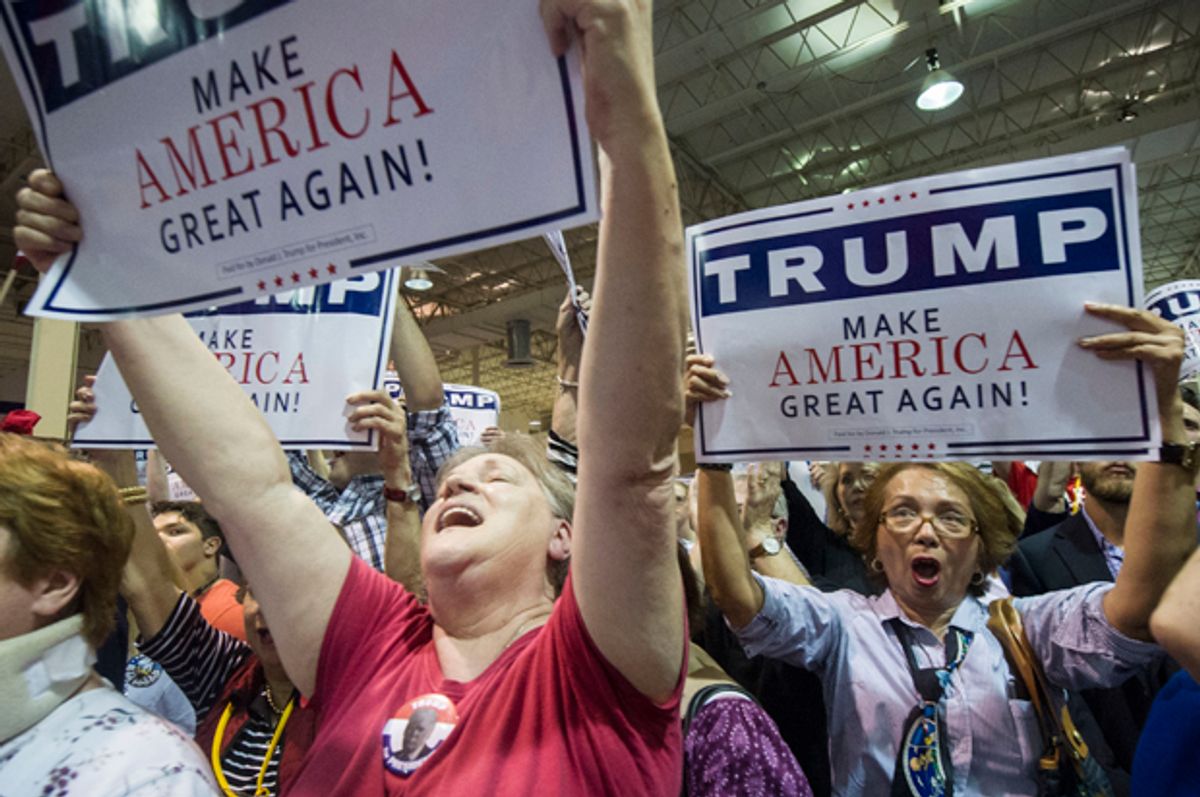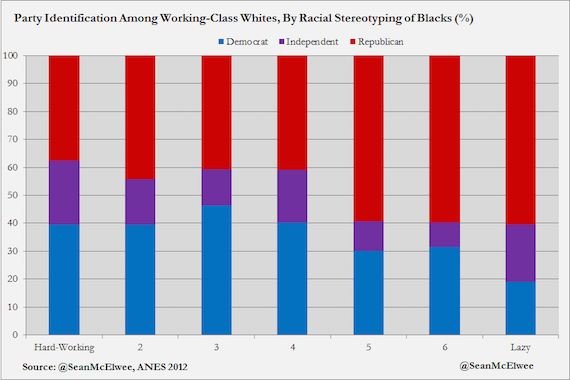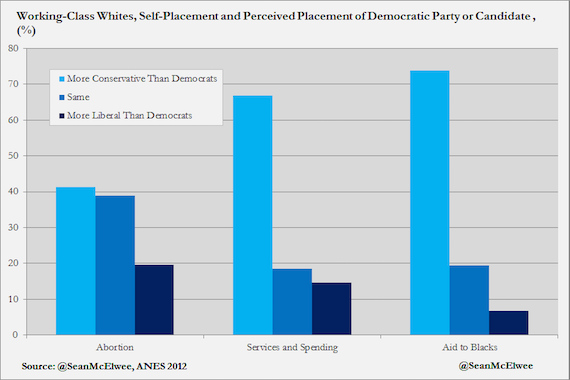What’s up with working-class whites? It’s a question that’s been asked for decades, and has been raised again recently in the discussion surrounding an Alec MacGillis piece examining Matt Bevin’s recent election gubernatorial win in Kentucky, which could leave many in Kentucky without Medicaid. Though there are many explanations for why working class whites vote Republican and many are certainly true, the overwhelming reason is rather simple: racism.
To see why working class whites -- defined as non-Hispanic whites without a college degree, although there are extensive debates as to the best way to define “working class” -- aren’t voting Democratic, I use the American National Election Studies 2012 survey. To begin, I examined raw vote shares among working class whites, and then vote shares among working class whites in the South (the former 11 states of the Confederacy) and non-South. Immediately, it is obvious that a key divide is the South/non-South distinction: only 28 percent of Southern working class whites identify as Democratic, compared with 40 percent of non-South working class whites.
Next, I examined whether racial stereotyping had any effect. The stereotype question asks respondents to rate Blacks on a scale of 1 (hard-working) to 7 (lazy). I examined the party identification of working class whites in each category and the results are rather suggestive: among working class whites who ranked Blacks as hard-working, 40 percen were Democrats and 38 percent Republicans, among those who said Blacks are lazy, 20 percent were Democrats and 60 percent were Republicans.
But how does this affect the votes of working class whites? My next analysis teases out whether social issues play a role in white votes, as Thomas Frank has suggested; whether it’s concerns about the role of government, as John Judis (and others) have argued; or whether it’s racism, as Ian Haney-Lopez has argued.
Specifically, I examine three questions that allow respondents to place themselves on a scale and also place the major parties (or candidates) on the same scale. I examine three questions: a four-point scale regarding abortion, a seven-point scale regarding government services and spending and a seven-point scale regarding aid to Blacks (see here for exact wording). The first two ask respondents to put themselves on a scale and also place the Republican and Democratic party on the scale, the last asks the respondents to place themselves as well as Mitt Romney and Obama on the scale (this may skew results because people may perceive Obama as more supportive of aid to Blacks than Democrats in general, likely because of racism).
I find that 62 percent of working-class whites either put Romney at the same place as them on aid to Blacks or within 1 point in either direction, compared with only 35 percent of working-class whites who felt that way about Obama. About 40 percent of working class whites placed themselves at the same place or within one point in either as Democrats on government services or spending, compared with 53 percent who perceived closeness with the Republican party. On the abortion scale 31 percent of respondents placed themselves as the same as Republicans, compared with 39 percent who felt the same way about Democrats. Because abortion was only a four point scale, I didn’t compare what percentage of people placed themselves within one point of either party (the chart shows the percentage placing themselves the same as the parties).
Working class whites say they are overwhelmingly more liberal than the Republican party on abortion and modestly more liberal on government services and spending. However, they are more conservative than Romney on aid to Blacks. When compared to the Democratic party, working class whites say they are more conservative on abortion (only slightly) and dramatically more conservative on services and spending. More than 70 percent of working class whites say they are more conservative than Obama on aid to Blacks. This suggests that working class whites see themselves as far closer to the Democratic party on abortion and further away from the party on services and spending. They see themselves furthest away from Obama on the issue of aid to Blacks.
These results are suggestive, and they fit into a broader academic literature. In a recent National Bureau of Economic Research working paper, Ilyana Kuziemko and Ebonya Washington find that racism can explain almost all of the decline of Southern white support for Democrats between 1958 and 2000. Larry Bartels performed a similar (although far more detailed) analysis in a 2006 paper criticizing Frank and found similarly, that working class voters were closer to Republicans on economic and racial issues, but agreed with Democrats on abortion and women’s role in the family. In his masterful work, "Why Americans Hate Welfare," Martin Gilens finds that opposition to welfare is driven by racial stereotypes about blacks. In a seminal book, "Race and the Decline of Class in American Politics," Robert Huckfeldt and Carol Weitzel Kohfeld show that the more a state-level Democratic party relies on Black votes, the less likely low income whites in the states were to vote Democratic. Ian Haney-Lopez argues that Republican politicians have consciously played up racial tensions and animosity to peel white votes away from the Democratic party.
Another clue comes from the fact that working class Latinos and Blacks all overwhelmingly prefer Democrats, and the non-white working class as a whole prefers Democrats to Republicans 68 percent to 16 percent. The only defectors are the white working class.
So if the working class generally likes Democrats (with the exception of working-class whites), why do Democrats lose elections? The key is turnout, a point MacGillis makes, citing some of my research.
The core question then, for Democrats, is how to mobilize the low-income voters who are disproportionately harmed by Republican policies. Here, the Affordable Care Act includes a self-inflicted wound by Democrats. For decades, many states have failed to meet the NVRA requirement, which states that Medicaid offices and other public assistance agencies ask recipients whether they want to register to vote. Further, NVRA covers the federally mandated health care exchanges, but the Obama administration has failed to require the exchanges to offer participants an opportunity to register to vote. Both offer a huge missed chance to register millions of new voters, disproportionately low-income and non-white.
Understanding why Democrats have lost working-class whites is a key to understanding the future. On the positive side, the decline of the white working class and the increasing racial diversity of the nation could help Democrats, if they could mobilize non-white members of the working class to vote at the same rate as working class whites. As I’ve noted, the rise in diversity of the general population has only slowly been reflected in the diversity of the electorate. On the other hand, the idea that Democrats are losing votes because of their socially progressive stances on abortion and gay rights are clearly incorrect. Further, while it’s clear that economic progressivism might struggle because Americans fail to link public policy to rising inequality, there is also evidence that many economically progressive policies are popular.
The problem, as new research by political scientists Torben Iversen and David Soskice shows, is that the U.S. doesn’t have a strong union movement to mobilize low income people. As they note, and as Fowler and Michele Margolis show, another factor is information: When people are informed they shift their toward the Democratic party. Political scientists Jan Leighley and Jonathan Nagler note that people who see greater differences between the parties were more likely to vote, but low-income people are less likely to perceive large differences. Progressives must see registering and mobilizing low-income voters as a central priority. Supporting unions, which serve an important role in mobilizing the working-class, is also vital. However, progressive must also give the working class a good reason to vote for them.







Shares